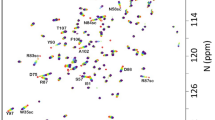Summary
A hypothesis for the hemoglobin oxygen reaction after the procedure of “minimal model” is developed, which is able to explain quantitatively the dependence of molecular weight and of the O2 dissociation curve on the hemoglobin concentration. After this hypothesis the tetramer hemoglobin dissociates symmetrically into its dimer and monomer subunits. Each of these subunits has a specific O2 affinity, which is the same for every stage of their oxygenation. An essential aspect of this hyothesis, moreover, is the effect of a low molecule intermediary substance, Z, which stabilizes the tetramer. The parameter values obtained from the numerical calculations allow the Z substance to be identified with Ca++ and/or Mg++. By taking into consideration the complex-forming tendency of these bivalent ions, the other known properties of the O2 dissociation curve can be easily qualitatively explained. Because of the great importance of this complex-forming property, we call the model a coordination hypothesis.
Zusammenfassung
Es wird nach der Methode des einfachsten Modells eine Hypothese für die Hämoglobin-Sauerstoff-Reaktion entwickelt, die es erlaubt, u. a. die Abhängigkeit der O2-Bindungskurve und des Molekulargewichts von der Hämoglobinkonzentration zu beschreiben. Nach dieser Hypothese zerfällt das tetramere Hämoglobin symmetrisch in seine dimeren und monomeren Untereinheiten. Jeder dieser Untereinheiten kommt eine spezifische, für alle Oxygenierungsstufen gleiche O2-Affinität zu. Ein wesentlicher Bestandteil der Hypothese ist ferner die Wirkung einer niedermolekularen, das tetramere Hämoglobin stabilisierenden Zwischensubstanz Z. Die aus den numerischen Rechnungen erhaltenen Werte der Parameter geben Anlaß, die Z-Substanz mit Ca++ und/oder Mg++ zu identifizieren. Unter Berücksichtigung der Tatsache, daß diese zweiwertigen Ionen Komplexe bilden, lassen sich die weiteren bekannten Eigenschaften der O2-Bindungskurve qualitativ zwanglos deuten. Wegen der großen Bedeutung der Komplexbildung bezeichnen wir diese Modellvorstellung als Koordinationshypothese.
Similar content being viewed by others
Literatur
Adair, G. S.: The hemoglobin system. VI. The oxygen dissociation curve of hemoglobin. J. biol. Chem.63, 529 (1925).
Antonini, E.: Interrelationship between structure and function in hemoglobin and myoglobin. Physiol. Rev.45, 123 (1965).
—,M. Brunori, andS. Anderson: Studies on the relations between molecular and functional properties of hemoglobin. VII. Kinetic effects of the reversible dissociation of hemoglobin into single chain molecules. Biol. Chem.243, 1816 (1968).
Barnikol, W. K. R., u.G. Thews: Zur Dissoziation des Human-Hämoglobin. Pflügers Arch.309, 224 (1969).
Benesch, R., andR. E. Benesch: The effect of organic phosphates from the human erythrocyte on the allosteric properties of hemoglobin. Biochem. Biophys. Res. Commun.26, 162 (1967).
Chanutin, A., andR. Curnish: Effect of organic and inorganic phosphates on the oxygen equilibrium of human erythrocytes. Arch. Biochem.121, 96 (1967).
Davies, C. W.: Ion association. London: Butterworths 1962.
Frank, R. N. G., K. E. Falk, B. O. G. Malmström, andT. Vanngard: The conformational transition of sperm whale ferrimyoglobins in the presence of several equivalents of cupric ion. J. biol. Chem.242, 5731 (1967).
Garby, L., G. Gerber, andC.-H. de Verdier: Binding of ATP and 2,3-DPG to hemoglobin. In: Stoffwechsel und Membranpermeabilität von Erythrocyten und Thrombocyten S. 66. Stuttgart: Thieme 1968.
Gibson, Q. H.: The kinetics of reactions between hemoglobin and gases. Progr. Biophys.9, 1 (1959).
Gleichman, U., H. v. Stuckard u.M. Zindler: Methode zur Bestimmung des intracellären Säure-Basen-Haushaltes (pH,pCO2, Standardbicarbonat, Basenüberschuß) in Erythrocyten. Pflügers Arch. ges. Physiol.283, 43 (1965).
Grote, J.: Die Bestimmung der Sauerstoffbindungskurve von hochverdünnten Hämoglobinlösungen. Pflügers Arch. ges. Physiol.296, 202 (1967).
Hutten, H.: Computer analysis of oxyhemoglobin dissociation curves. In: Oxygen transport in blood and tissue. Stuttgart: G. Thieme 1968.
Koshland, D. E., Jr.,G. Nemethy, andD. Filmer: Comparison of experimental binding data and theoretical models in proteins containing subunits. Biochemistry5, 365 (1966).
Martell, A. E., u.G. Schwarzenbach: Adenosinphosphate und Triphosphat als Komplexbildner für Calzium und Magnesium. Helv. Chim. Acta39, 653 (1956).
Monod, J., J. Wyman, andJ.-D. Changeux: On the nature of allosteric transitions: a plansible model. J. mol. Biology12, 88 (1965).
Niesel, W.: Die Umlagerungshypothese. Ein Beitrag zur Klärung der Sauerstoff-Hämoglobin-Reaktion. Dissertation, Kiel 1961.
Parkhurst, L. J., andQ. H. Gibson: The reaction of carbon monoxide with horse hemoglobin in solution, in erythrocytes, and crystals. J. biol. Chem.242, 5762 (1967).
Riggs, A.: Functional properties of hemoglobins. Physiol. Rev.45, 619 (1965).
Rossi Fanelli, A., E. Antonini, andA. Caputo: Hemoglobin and myoglobin. Advanc. Protein Chem.19, 73 (1964).
Roughton, F. J. W.: Diffusion and simultaneous chemical reaction velocity in hemoglobin solutions and red cell suspensions. Progr. Biophys.9, 56 (1959).
Schachman, H. K., andS. J. Edelstein: Ultracentrifuge studies with absorption optics IV. Molecular weight determinations at microgramm level. Biochemistry5, 2681 (1966).
Schejter, A.: The role of intermolecular interactions, as distinct from intra-molecular interactions in hemoglobin-oxygen equilibria hemes and proteins, p. 247. London: Academic Press 1966.
Severinghaus, J. W.: Blood gas calculator. J. appl. Physiol.21, 1108 (1966).
Sommerkamp, H., K. Riegel, P. Hilpert u.K. Brecht: Über den Einfluß der Kationenkonzentration im Erythrocyten auf die Lage der Sauerstoffdissoziationskurve des Blutes. Pflügers Arch. ges. Physiol.272, 591 (1961).
Thews, G.: Die theoretischen Grundlagen der Sauerstoffaufnahme in der Lunge. Ergebn. Physiol.53, 41 (1963).
Waldeck, F., u.R. Zander: Lageveränderungen der Sauerstoffbindungskurve in Abhängigkeit von intraerythrocytären Kationen- und Hämoglobinkonzentrationen. Pflügers Arch. ges. Physiol.294, 42 (1967).
Wolf, U. H.: Kinetik der Wirkung von Alkalimentallionen auf die Acetylcholinesterase. Dissertation, Mainz 1965.
Wymann, Jr., J.: Linked functions and reciprocal effects in hemoglobin: a second look. Advanc. Protein Chem.19, 223 (1964).
Zander, R.: Zur Interpretation des O2-Bindungskurvenverlaufs. I. Mitteilung. Der Eintluß des Löslichkeitskoeffizienten auf die Darstellung der O2-Bindungskurve. Pflügers Arch.308, 127 (1969).
Author information
Authors and Affiliations
Rights and permissions
About this article
Cite this article
Barnikol, W.K.R., Thews, G. Zur Interpretation der O2-Bindungskurve des Human-Hämoglobins. Pflugers Arch. 309, 232–249 (1969). https://doi.org/10.1007/BF00586801
Received:
Issue Date:
DOI: https://doi.org/10.1007/BF00586801




